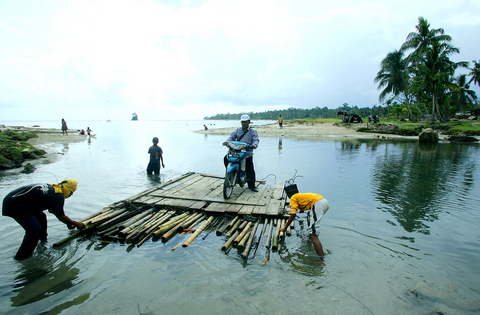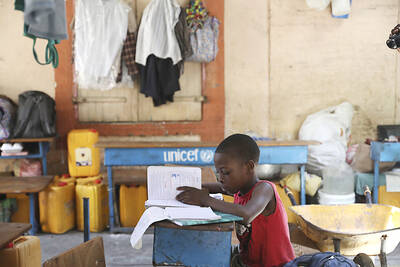The ground shook so hard, people couldn't stand up when the massive earthquake rattled this remote Indonesian island -- the closest inhabited land to the epicenter of the devastating temblor.
But, unlike the hundreds of thousands of others who thought the worst was over when the shuddering stopped, the islanders remembered their grandparents' warnings and fled to higher ground in fear of giant waves known locally as semong.
Within 30 minutes, Simeulue became the first coastline in the world to experience the awesome force of the Dec. 26 tsunami. But only seven of the island's 75,000 people died, thanks to the stories passed down over the generations.

PHOTO: AP
"After the earthquake, I looked for the water to suck out," said Kiro, 50, who like many Indonesians uses one name. "I remember the story of the semong and I ran to the hill."
Simeulue's northern coast is about 60km from the spot where the magnitude-9.0 earthquake shifted the ocean floor along a fault line west of Sumatra Island with enough force to send waves racing across the Indian Ocean.
Waves as high as 10m smacked ashore here, but most people had fled because of the stories about the semong that killed thousands in 1907.
"Everyone ran to the hills," said Randa Wilkinson of the aid agency Save the Children. "They took bicycles and motorbikes and wheelbarrows and piled the kids in whatever they could get them in."
Suhardin, 33, said that when the quake struck he didn't think about his grandmother's stories about the 1907 disaster because nothing happened when another big temblor shook the island three years ago. It was only when a man from another village ran past shouting "Semong! Semong!" that Suhardin and others from Laayon village fled.
The earthquake's power is visible all along Simeulue's picturesque coast. Huge cracks and gashes scar the remains of thick concrete walls that once supported village mosques, bridges lie crumbled in streams running to the ocean and deep fissures split roadways.
The island's northern shore took a direct hit from the waves, which left little standing. Along the western shore, the tsunami spared some villages and destroyed others, leaving a path of snapped palm trees, flattened houses and power poles dangling over roads.
The earthquake tipped the island up 1.2m on one side, exposing rugged blocks of coral reef along parts of the northern coast, said Taufik, an Indonesian official who surveyed the island for the government's meteorological and geophysical agency.
Palm trees that once shaded white-sand beaches are now partially submerged on the southern end of the island, which sank 30cm.
"You can't imagine this and only seven people died," he said. "It's amazing."
He agreed the island's oral history saved countless lives, but noted its lush hills are close to the coast, allowing people to get to safety. In many other places with broader coastal plains, people had few places to run.
Tsunamis are rare in the Indian Ocean and many people in the 11 countries hit by the waves did not know about their potential to swallow tens of thousands of lives in seconds. When the inrushing waves sucked shallow coastal waters out to sea, many people stood on beaches watching or collecting fish flopping on the sand instead of fleeing.
On Simeulue's western coast, survivors stood helplessly on hillsides looking down on the wall of water sweeping entire villages out to sea.
"We watched what we had -- everything -- was gone," said Sukirno, 50. "We stayed in the hills for one week because we were scared."
Some are so traumatized they have gathered planks of wood and built shanties along a road high on a hill overlooking what is left of their seaside village. As aftershocks continue -- some registering magnitude 6.0 -- they say they are in no hurry to return to the lowlands.
But many people have begun rebuilding along the shore, starting with crude wooden shacks on what is left of concrete foundations.
They say they will pass the story of the semong down to future generations, even if another disaster never happens.

POLITICAL PRISONERS VS DEPORTEES: Venezuela’s prosecutor’s office slammed the call by El Salvador’s leader, accusing him of crimes against humanity Salvadoran President Nayib Bukele on Sunday proposed carrying out a prisoner swap with Venezuela, suggesting he would exchange Venezuelan deportees from the US his government has kept imprisoned for what he called “political prisoners” in Venezuela. In a post on X, directed at Venezuelan President Nicolas Maduro, Bukele listed off a number of family members of high-level opposition figures in Venezuela, journalists and activists detained during the South American government’s electoral crackdown last year. “The only reason they are imprisoned is for having opposed you and your electoral fraud,” he wrote to Maduro. “However, I want to propose a humanitarian agreement that

ECONOMIC WORRIES: The ruling PAP faces voters amid concerns that the city-state faces the possibility of a recession and job losses amid Washington’s tariffs Singapore yesterday finalized contestants for its general election on Saturday next week, with the ruling People’s Action Party (PAP) fielding 32 new candidates in the biggest refresh of the party that has ruled the city-state since independence in 1965. The move follows a pledge by Singaporean Prime Minister Lawrence Wong (黃循財), who took office last year and assumed the PAP leadership, to “bring in new blood, new ideas and new energy” to steer the country of 6 million people. His latest shake-up beats that of predecessors Lee Hsien Loong (李顯龍) and Goh Chok Tong (吳作棟), who replaced 24 and 11 politicians respectively

Young women standing idly around a park in Tokyo’s west suggest that a giant statue of Godzilla is not the only attraction for a record number of foreign tourists. Their faces lit by the cold glow of their phones, the women lining Okubo Park are evidence that sex tourism has developed as a dark flipside to the bustling Kabukicho nightlife district. Increasing numbers of foreign men are flocking to the area after seeing videos on social media. One of the women said that the area near Kabukicho, where Godzilla rumbles and belches smoke atop a cinema, has become a “real

‘POINT OF NO RETURN’: The Caribbean nation needs increased international funding and support for a multinational force to help police tackle expanding gang violence The top UN official in Haiti on Monday sounded an alarm to the UN Security Council that escalating gang violence is liable to lead the Caribbean nation to “a point of no return.” Special Representative of the UN Secretary-General for Haiti Maria Isabel Salvador said that “Haiti could face total chaos” without increased funding and support for the operation of the Kenya-led multinational force helping Haiti’s police to tackle the gangs’ expanding violence into areas beyond the capital, Port-Au-Prince. Most recently, gangs seized the city of Mirebalais in central Haiti, and during the attack more than 500 prisoners were freed, she said.